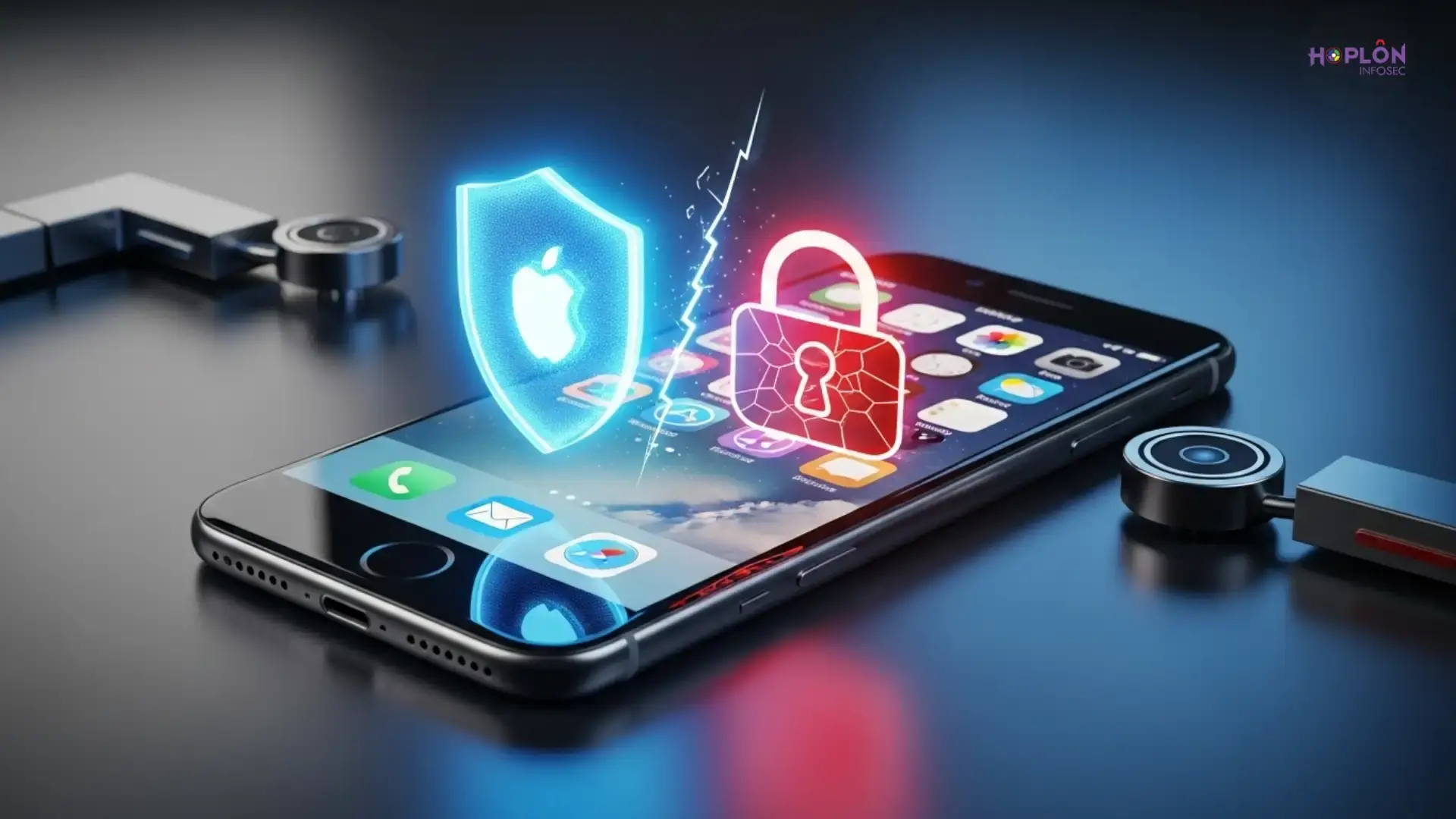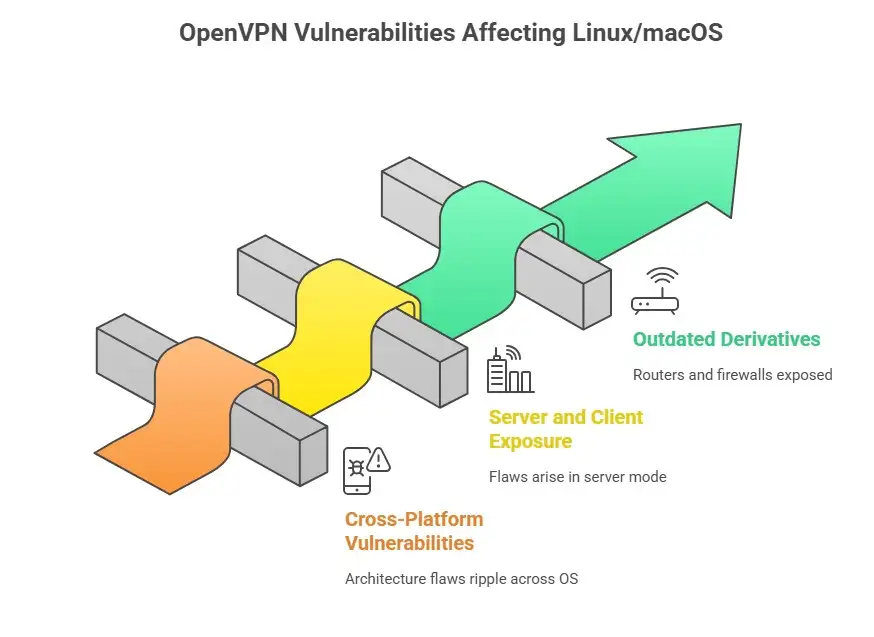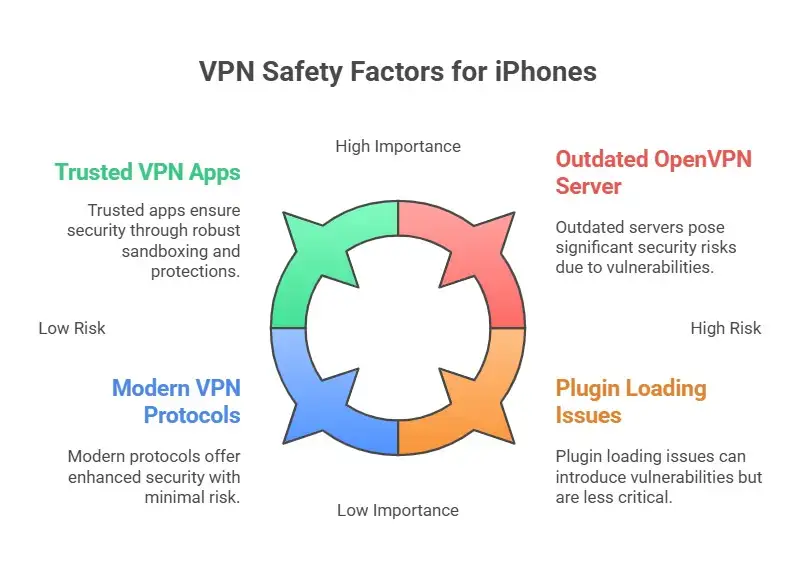Is VPN Safe for iPhone? What the Latest OpenVPN Vulnerability on Linux and macOS Means

Hoplon InfoSec
28 Oct, 2025
OpenVPN released version 2.7_beta2 on October 27, 2025, fixing DNS injection risks, Windows logging issues, IPv4 broadcast on Linux, and other bugs; stable 2.6.x is recommended for production.
If you’ve ever wondered, “Is VPN safe for iPhone?” you’re not alone. Many of us turn to a VPN (Virtual Private Network), believing it’s a bulletproof shield, especially on mobile devices like an iPhone. But what if the underlying software has a crack in it? Recently, a significant vulnerability in the widely used open‐source tool OpenVPN (used on Linux, macOS, and elsewhere) has exposed systems to script injection and related attacks.
That raises important questions: if OpenVPN can be compromised on desktops, how confident can we feel about our mobile VPN safety? In this article, we’ll explore how the OpenVPN vulnerability works, why it matters for Linux and macOS users, and what iPhone users should take into account when asking, “Is VPN safe for iPhone?”
What’s the vulnerability in OpenVPN?
Over the past year, the OpenVPN ecosystem has seen multiple security flaws. For instance:
· In 2024, vulnerabilities identified as CVE‑2024‑24974, CVE‑2024‑27459, and CVE‑2024‑27903 allowed attackers to chain exploits leading to remote code execution (RCE) or local privilege escalation (LPE) on Windows systems running OpenVPN.
· A noteworthy one for mobile: CVE‑2024‑8474-On Android (via the OpenVPN Connect client), a private key was logged in clear text, meaning a determined attacker with physical device access could theoretically decrypt VPN traffic.
· More recently, in 2025, a denial-of-service (DoS) vulnerability, CVE‑2025‑2704, was disclosed: OpenVPN versions 2.6.1 through 2.6.13, when using the tls-crypt-v2 directive in server mode, are vulnerable to remote packet corruption/replay leading to service crash.
So what does “script injection” mean in this context? While some descriptions say “script injection,” what many vulnerability records describe are flaws in plugin loading, driver handling, named pipes, and handshake manipulation. For example, one vulnerability allowed arbitrary plugins to be loaded from untrusted directories (CVE-2024-27903) on Windows.
Why Linux & macOS systems are at risk
Although many of the high‐profile OpenVPN flaws target Windows, the broader lesson is if your VPN stack isn’t maintained, you could become vulnerable. Here are two key reasons Linux/macOS users should care:
1. Same underlying software, multiple platforms. OpenVPN is cross‐platform, running on Linux, macOS, Windows, and others. A vulnerability in its architecture (for example, plugin loading, TLS handshake logic, or driver/adapter components) can ripple across OS lines.
2. Server-side and client-side exposure. Many of the flaws arise in server mode (i.e., when OpenVPN is acting as a VPN server) or in driver components, but client implementations (and how they handle credentials, keys, and logs) also matter. For instance, the clear‐text private key on Android (CVE-2024-8474) shows client-side risk. That hints that if you’re using OpenVPN on macOS (or via third‐party clients), you need to verify you’re up to date.
If a Linux/macOS system is running an outdated OpenVPN version (or a derivative such as a router firmware, VPN appliance, or firewall gateway using OpenVPN), it may be exposed. For example, vulnerability CVE-2025-2704 (the DoS bug) is documented for Linux server mode using TLS-crypt v2.

What this means for “Is VPN safe for iPhone?”
When we shift focus to the iPhone (or iPad), the question “Is VPN safe for iPhone?” requires a nuanced answer. A VPN is generally safe but not automatically bulletproof. Here’s how the recent OpenVPN vulnerabilities influence that discussion:
· iPhone clients may use OpenVPN or alternative protocols. Some VPN apps on iOS use the OpenVPN protocol (shim) or wrappers, but others use more modern protocols (e.g., WireGuard). The risk depends on the specific app and version. If your app uses OpenVPN under the hood, the client-side vulnerabilities (like key exposure) matter.
· Update discipline matters more than protocol. Even the best protocol is only as safe as its implementation and patching. If an iPhone app uses OpenVPN under the hood and isn’t updated to eliminate key exposure or plugin loading issues, then yes, “Is VPN safe for iPhone?” becomes “Safe if kept patched and configured correctly.”
· Server‐side weaknesses matter too. If you personally run a VPN server (or your provider uses an outdated OpenVPN server version), client devices, including iPhones, are only as safe as the weakest link. A server vulnerable to DoS or code execution on Linux/macOS (e.g., CVE‐2025‐2704) could introduce indirect risk.
· Use of trusted apps is essential. On iOS, because of app sandboxing and system protections, many of the more extreme exploits may require additional privileges (jailbreak, developer mode). For example, the Android private key risk for OpenVPN Connect required developer mode/USB debugging access. On an iPhone, a strong chain of privileges may still reduce risk but not eliminate it.
· The protocol is not the only factor. Other aspects, such as whether logs expose sensitive data (as happened for OpenVPN Connect on Android), whether plugins or extensions can be loaded, and whether the driver/adapters have flaws, also influence security. So “is VPN safe for iPhone?” isn’t just about “uses OpenVPN” vs “doesn’t” but about app integrity, updates, configuration, trustworthiness of provider, etc.

Real‐life scenario: what could happen
Let’s walk through a plausible scenario to illustrate how these vulnerabilities might play out (and what the user could do to avoid trouble).
Imagine Sarah runs a small business from home on her Linux server and uses OpenVPN Access Server to allow remote work. She’s also using a VPN app on her iPhone that uses the OpenVPN protocol to connect to her server. She hasn’t updated her server software in 6 months.
· Because her server is running OpenVPN version 2.6.5 with tls-crypt-v2 enabled, it is susceptible to CVE-2025-2704. An attacker, monitoring network traffic or injecting malicious packets during the handshake, could trigger a server crash or, worse, start a foothold.
· Meanwhile, on her iPhone, the VPN client uses its OpenVPN plugin implementation, which is version 3.4 (before the fix for CVE-2024-8474). Although physical access is required for some exploits, if the phone is lost or compromised (e.g., forwarded logs, developer mode), the private key could be exposed, allowing decryption of VPN traffic.
· If the attacker combined server vulnerability (knocking Sarah’s VPN offline or causing unexpected behavior) with client log exposure or key leak, the attacker might intercept or hijack the VPN session, thereby compromising what Sarah believed to be “safe.”
If instead, Sarah had updated her OpenVPN server to the patched version (after April 2025) and used a well‐maintained iOS VPN client that uses OpenVPN with the fixed version (or switched to a protocol like WireGuard), her risk would be dramatically lower.
So, answering the question: is VPN safe for iPhone?
Yes, and with caveats. The short answer: a VPN can be safe for iPhone, but only if properly configured, kept up‐to‐date, and managed with awareness of underlying risks. The emergence of recent vulnerabilities in OpenVPN shows that even trusted protocols and software aren’t immune.
If you blindly assume “VPN = safety” without checking versions, configurations, provider credentials, or client app updates, you could be exposing yourself rather than protecting yourself.
Given the vulnerabilities in OpenVPN (script injection/privilege escalation/DoS) and the client-side issues (key logging), it’s wise to treat your VPN as a layer of protection, not a magic shield. Stay informed, stay updated, and make smart choices. That way, when you ask, “Is VPN safe for iPhone?”, you can say, “Yes, here’s how I made it so.”
Wrap-Up
In today’s digital environment, using a VPN on your iPhone is a smart step toward safeguarding your online privacy, but it’s not enough to just flip the “connect” switch and assume you’re impervious.
The recent vulnerabilities in OpenVPN (including critical ones in 2024 and 2025) highlight the importance of vigilance: staying on top of software updates, selecting providers that maintain strong protocols, hardening configurations if you manage your own VPN server, and choosing apps that protect your device end‐to‐end. When you take those steps, you can confidently answer the question, “Is VPN safe for iPhone?” with a resounding “yes, when done properly.”
If you’d like help reviewing specific iPhone VPN apps or walking through hardening your own server, I’m happy to help.
You can also read these important cybersecurity news articles on our website.
· Apple Update,
For more, please visit our homepage and follow us on X (Twitter) and LinkedIn for more cybersecurity news and updates. Stay connected on YouTube, Facebook, and Instagram as well. At Hoplon Infosec, we’re committed to securing your digital world.
Share this :